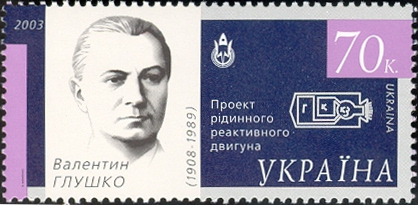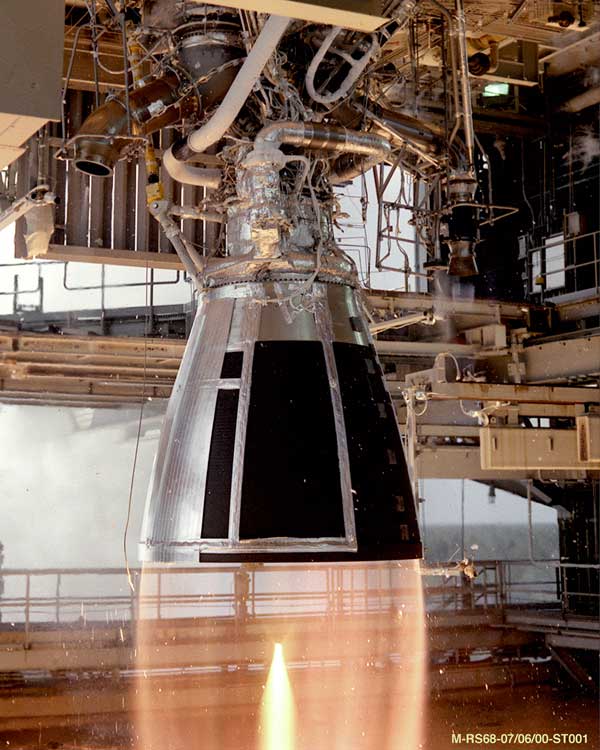|
RD-107
The RD-107 () and its sibling, the RD-108, are a type of rocket engine used on the R-7 rocket family. RD-107 engines are used in each booster and the RD-108 is used in the central core. The engines have four main combustion chambers (each with a nozzle) and either two (RD-107) or four (RD-108) vernier chambers. The engines were first developed in the mid-1950s to launch the R-7 Semyorka, the first intercontinental ballistic missile. The R-7 was later adapted into space launch vehicles and the engines have been improved over several generations. The most recent versions are the RD-107A and RD-108A engines are used to launch the Soyuz-2, which is in active service . Design The RD-107 was designed under the direction of Valentin Glushko at the Experimental Design Bureau (OKB-456) between 1954 and 1957. It uses liquid oxygen and kerosene as propellants operating in a gas-generator cycle. As was typical by all the descendants of the V-2 rocket technology, the turbine is drive ... [...More Info...] [...Related Items...] OR: [Wikipedia] [Google] [Baidu] |
NPO Energomash
NPO Energomash "V. P. Glushko" is a major Russian rocket engine manufacturer. The company primarily develops and produces Liquid rocket engine, liquid propellant rocket engines. Energomash originates from the OKB, Soviet design bureau OKB-456, which was founded in 1946. NPO Energomash acquired its current name on May 15, 1991, in honor of its former chief designer Valentin Glushko. Energomash is noted for its long history of large scale liquid oxygen, LOX/Kerosene engine development. Notable examples are the RD-107/RD-108 engines used on the R-7 Semyorka, R-7, Molniya (rocket), Molniya and Soyuz (rocket family), Soyuz rocket families, and the RD-170, RD-171 and RD-180 engines used on the Energia (rocket), Energia, Zenit (rocket), Zenit and Atlas V launch vehicles. , the company remained largely owned by the Government of Russia, federal government of Russia, but RSC Energia owned approximately 14% of the total shares. , NPO Energomash employed approximately 5500 workers at its h ... [...More Info...] [...Related Items...] OR: [Wikipedia] [Google] [Baidu] |
Soyuz-2
Soyuz2 (; GRAU index: 14A14) is a Russian expendable medium-lift launch vehicle and the seventh major iteration of the Soyuz rocket family. Compared to its predecessors, Soyuz-2 features significant upgrades, including improved engines and a digital flight control system that enables launches from fixed platforms and supports larger payload fairings. Developed by the Progress Rocket Space Centre (RKTs Progress) in Samara, Soyuz-2 is used to place payloads into low Earth orbit in standard configuration but can also support missions to higher orbits using an additional upper stage, most commonly the Fregat, though the smaller Volga is available as a less expensive option. Since its introduction in 2004, Soyuz-2 has gradually replaced earlier Soyuz variants and is launched from the facilities of its R-7 derived predecessors: Site 31/6 at the Baikonur Cosmodrome in Kazakhstan and Sites 43/3 and 43/4 at the Plesetsk Cosmodrome in northwestern Russia, and, since 2016, Site ... [...More Info...] [...Related Items...] OR: [Wikipedia] [Google] [Baidu] |
JSC Kuznetsov
JSC Kuznetsov () is one of the leading Russian producers of aircraft engines, liquid-propellant rocket engines as well as aeroderivative gas turbines and modular stations. The current joint-stock company was established through the consolidation of several Samara, Russia, Samara-based aerospace engine companies, including JSC N.D. Kuznetsov SNTK, JSC Samara Design Bureau of Machine Building and JSC NPO Povolzhskiy AviTI. History The company was established in 1912 as the Gnome Factory of Moscow, after the French aircraft engine company Gnome et Rhône which supplied the engine parts assembled by the plant. In 1925 it was renamed 'Frunze Factory No. 24', after Bolshevik leader Mikhail Frunze. The factory was evacuated to its current location in Samara in 1941. The Samara Frunze Engine-Building Production Association was one of the principal aerospace engine production complexes in Russia, with six plants and 25,000 employees in the early 1990s. It has produced turbojet and turbop ... [...More Info...] [...Related Items...] OR: [Wikipedia] [Google] [Baidu] |
R-7 Semyorka
The R-7 Semyorka (, GRAU index: 8K71) was a Soviet Union, Soviet missile developed during the Cold War, and the world's first intercontinental ballistic missile. The R-7 made 28 launches between 1957 and 1961. A derivative, the R-7A Semyorka, R-7A, was operational from 1960 to 1968. To the West it was unknown until its launch (later it would get the NATO reporting name SS-6 Sapwood). In modified form, it launched Sputnik 1, the first artificial satellite, into orbit, and became the basis for the R-7 (rocket family), R-7 family which includes Sputnik (rocket), Sputnik, Luna (rocket), Luna, Molniya (rocket), Molniya, Vostok (rocket family), Vostok, and Voskhod (rocket), Voskhod Expendable launch system, space launchers, as well as later Soyuz (rocket family), Soyuz variants. Various modifications are still in use and it has become the world's most reliable space launcher. Description The R-7 was long, in diameter and weighed ; it had a single stage with four strap on boosters p ... [...More Info...] [...Related Items...] OR: [Wikipedia] [Google] [Baidu] |
Gas-generator Cycle (rocket)
The gas-generator cycle, also referred to as the GG cycle or colloquially as an open cycle, is one of the most commonly used power cycles in bipropellant liquid rocket engines. Propellant is burned in a gas generator (analogous to, but distinct from, a preburner in a staged combustion cycle) and the resulting hot gas is used to power the propellant pumps before being exhausted overboard and lost. Because of this loss, this type of engine is considered an open cycle (note other open cycles exist, e.g. the tap-off bleed cycle). The gas generator cycle exhaust products pass over the turbine's rotor(s) first. Then they are expelled overboard. They can be expelled directly from the turbine, or are sometimes expelled into the nozzle (downstream from the throat) for both a small gain in efficiency, and can serve as film cooling. An advantage of this cycle is the high pressure drop available to the turbine (GG chamber pressure down to ambient) for extracting work from the drive gas; at ... [...More Info...] [...Related Items...] OR: [Wikipedia] [Google] [Baidu] |
Valentin Glushko
Valentin Petrovich Glushko (; ; born 2 September 1908 – 10 January 1989) was a Soviet engineer who was program manager of the Soviet space program from 1974 until 1989. Glushko served as a main designer of rocket engines in the Soviet program during the heights of the Space Race between United States and the Soviet Union, and was the proponent of cybernetics within the space program. Biography Valentin Glushko was born on 2 September 1908 (21 August according to the old calendar) in Odesa to a Ukrainian cossack father and a Russian peasant mother. At the age of fourteen he became interested in aeronautics after reading novels by Jules Verne. He is known to have written a letter to Konstantin Tsiolkovsky in 1923. He studied at an Odessa trade school, where he learned to be a sheet metal worker. After graduation he apprenticed at a hydraulics fitting plant. He was first trained as a fitter, then moved to lathe operator. During his time in Odessa, Glushko performed experiment ... [...More Info...] [...Related Items...] OR: [Wikipedia] [Google] [Baidu] |
Rocket Engine
A rocket engine is a reaction engine, producing thrust in accordance with Newton's third law by ejecting reaction mass rearward, usually a high-speed Jet (fluid), jet of high-temperature gas produced by the combustion of rocket propellants stored inside the rocket. However, non-combusting forms such as cold gas thrusters and nuclear thermal rockets also exist. Rocket vehicles carry their own oxidiser, unlike most combustion engines, so rocket engines can be used in a vacuum, and they can achieve great speed, beyond escape velocity. Vehicles commonly propelled by rocket engines include missiles, Rocket-assisted projectile, artillery shells, ballistic missiles and rockets of any size, from tiny Rocket (firework), fireworks to Rocket (weapon), man-sized weapons to huge Space vehicle, spaceships. Compared to other types of jet engine, rocket engines are the lightest and have the highest thrust, but are the least propellant-efficient (they have the lowest specific impulse). The ideal ... [...More Info...] [...Related Items...] OR: [Wikipedia] [Google] [Baidu] |
Vernier Thruster
A vernier thruster is a rocket engine used on a spacecraft or launch vehicle for fine adjustments to the attitude or velocity. Depending on the design of a craft's maneuvering and stability systems, it may simply be a smaller thruster complementing the main propulsion system, or it may complement larger attitude control thrusters, or may be a part of the reaction control system. The name is derived from vernier calipers (named after Pierre Vernier) which have a primary scale for gross measurements, and a secondary scale for fine measurements. Vernier thrusters are used when a heavy spacecraft requires a wide range of different thrust levels for attitude or velocity control, as for maneuvering during docking with other spacecraft. On space vehicles with two sizes of attitude control thrusters, the main ACS (Attitude Control System) thrusters are used for larger movements, while the verniers are reserved for smaller adjustments. Due to their weight and the extra plumbing requi ... [...More Info...] [...Related Items...] OR: [Wikipedia] [Google] [Baidu] |
Hydrogen Peroxide
Hydrogen peroxide is a chemical compound with the formula . In its pure form, it is a very pale blue liquid that is slightly more viscosity, viscous than Properties of water, water. It is used as an oxidizer, bleaching agent, and antiseptic, usually as a dilute solution (3%–6% by weight) in water for consumer use and in higher concentrations for industrial use. Concentrated hydrogen peroxide, or "high-test peroxide", decomposes explosively when heated and has been used as both a monopropellant and an oxidizer in rocketry. Hydrogen peroxide is a reactive oxygen species and the simplest peroxide, a compound having an oxygen–oxygen single bond. It decomposes slowly into water and elemental oxygen when exposed to light, and rapidly in the presence of organic or reactive compounds. It is typically stored with a Stabilizer (chemistry), stabilizer in a weakly acidic solution in an opaque bottle. Hydrogen peroxide is found in biological systems including the human body. Enzymes that u ... [...More Info...] [...Related Items...] OR: [Wikipedia] [Google] [Baidu] |
Sodium
Sodium is a chemical element; it has Symbol (chemistry), symbol Na (from Neo-Latin ) and atomic number 11. It is a soft, silvery-white, highly reactive metal. Sodium is an alkali metal, being in group 1 element, group 1 of the periodic table. Its only stable isotope is 23Na. The free metal does not occur in nature and must be prepared from compounds. Sodium is the Abundance of elements in Earth's crust, sixth most abundant element in the Earth's crust and exists in numerous minerals such as feldspars, sodalite, and halite (NaCl). Many salts of sodium are highly water-soluble: sodium ions have been Leaching (chemistry), leached by the action of water from the Earth, Earth's minerals over eons, and thus sodium and chlorine are the most common dissolved elements by weight in the oceans. Sodium was first isolated by Humphry Davy in 1807 by the electrolysis of sodium hydroxide. Among many other useful sodium compounds, sodium hydroxide (lye) is used in Soap, soap manufac ... [...More Info...] [...Related Items...] OR: [Wikipedia] [Google] [Baidu] |





